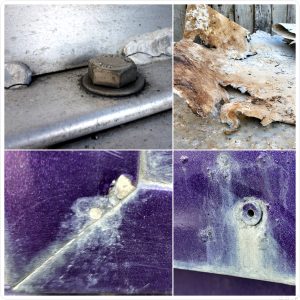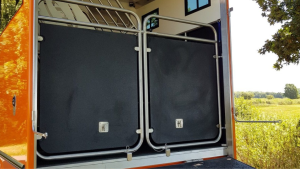Horsebox Aluminium
Horseboxes and a cautionary tale of mixing metals
Aluminium is without question an amazing product that, for mass-market vehicle manufacturers, is increasingly the material of choice. Due to massive research and development, the use of automotive aluminium has grown continuously for over 40 years and is now second only to steel as the most used material in vehicle manufacture. Large scale vehicle manufacturers are at the cutting edge of this technology and have invested heavily in its use and development. When we say large scale vehicle manufacturers, we are talking of millions of vehicles worldwide with research budgets of many millions. They have developed processes and products to compliment its use, along with testing procedures for strength and lifespan.
Horseboxes
For the equine community, the focus is now on overweight horseboxes, and in a short span of years aluminium has turned into a great product for weight saving. It should be noted that aluminium is not a cure all product for the manufacture of lightweight horseboxes. For all its positive attributes, it also has some quite significant weaknesses that customers should be aware of.
Firstly, the amount of research and development into using aluminium within the equine industry is trifling when compared to major vehicle manufacturers. In many cases, horsebox builders have little experience and use no research or development whatsoever. They simply copy what others do and repeat the same mistakes. The hope being that any failure is outside any warranty period!
Where aluminium is used in horseboxes, its failing tends to be that it does not ‘play well’ with other metals and can rot at a much-accelerated pace when used incorrectly. Sadly, much of the damage we see requiring repairs, is either from corner cutting to save production time or money… or simply poor engineering knowledge.
Where used correctly aluminium is a great product that lasts. It is excellent for external body work, including doors and cappings, where it has been used successfully for many decades. On the flip side, it is worth highlighting that where aluminium is used in structural areas like subframes, plank floors or ramps, flexing will inevitably cause damage, and this is usually along welds, joints with rivets or bolts and joints. For horse safety reasons where aluminium is used structurally, we would advise regular inspections becoming a matter of routine. I would add that over the years we have repaired many so-called lightweight aluminium ramps and in every case the damage caused by flexing and poor construction techniques has caused accelerated rot and joint cracking.

As an example, we repaired an ‘All Aluminium Horsebox Ramp’ of less than two years old. In this example, the horsebox was out of the warranty period by twelve months and had become the customer’s problem to fix. The ramp had failed with cracked corner joints and all the ramp hinge points had rotted where steel and aluminium were bolted together, prompting this cautionary tale of mixing metals… and hopefully giving some context to its correct use. I would reiterate that it is an excellent product when used correctly and this is not a post to dissuade customers from aluminium. Rather, it is to highlight what can and does go wrong with many horseboxes. It also highlights some questions you may want to ask your coachbuilder before placing an order.
Galvanic corrosion
The devil is in the details and the missing details on this ramp was poor engineering knowledge and a missing barrier between the aluminium and bare steel ramp parts. As this was the main cause of this ramp failure, I will take a moment to talk about galvanic corrosion. In simplified terms, galvanic corrosion is an electrochemical process in which one metal corrodes at an accelerated pace when two differing metals are directly touching. Over the years this issue accounts for much of the damage we see in our horsebox repair centre. In most cases it would have been avoided with a simple barrier between the two metals.
Ramp problems
- The first problem with the ramp in question was poor design. It was made from standard aluminium box sections, slightly thicker than the steel equivalent. In essence, it was a steel ramp design made in aluminium. Every joint was welded and had cracked; all showed some signs of metal fatigue caused by flexing. The welding of these joints allowed no flexing whatsoever and was a serious design flaw. Horsebox ramps are rarely on even ground and flexing is a big part of daily use. All designs optimised for aluminium need to be manufactured using sections up to 40% taller than the steel equivalent and the joints should be designed to allow for flexing.
- The second issue was the barrier separating the two dissimilar metals was not total. There was in fact, only paint between the steel and aluminium ramp frame. In essence, the advertised ‘All Aluminium Ramp’ had many mild steel parts including hinges and spring mounts bolted to the aluminium. The lack of a barrier between the dissimilar metals had caused severe galvanic corrosion of the aluminium box section, causing a catastrophic failure of the two spring mounts. Alarming, when you consider one ramp spring can have up to 6 tonnes of compression when the ramp is open!
- The third issue was that the bolts fixing the steel and aluminium together (dissimilar metals) also had no barrier between them and had contributed to further galvanic corrosion. This is common and something we also see on HGV horsebox subframes manufactured in aluminium. It was a theme running throughout this horsebox body and even the aluminium plank floor had corroded and cracked around the fixings. Unbelievably, these were small rivets! Unfortunately, this is the most common horse floor issue we see. To tick the ‘aluminium horse floor’ box and build as cheaply as possible, aluminium planks are riveted directly to steel or aluminium bearers.
- Other failures on this horsebox were the common mistakes we see all too often. It had been fully completed then sent somewhere else for paint! Many of the aluminium parts, especially where they had been cut, had started the oxidation process. It suffered from poor preparation, poor sealing, road spray and contamination. This presented as bubbling with white oxidation powder on the corners of doors, frames and around all external rivets and bolts. Sheets of paint were peeling away from large areas of the aluminium skirts and ramp, and this was caused by contamination, poor preparation and corner cutting.
Conclusion
As a conscientious manufacturer with quality, safety, and durability at the core of our designs, we have a love hate relationship with aluminium. We love it for its lightness and relatively low cost, and we hate it because it needs, extra engineering processes to add the durability and strength that we demand. Often the thickness and size of aluminium section we require dictates that we use the more expensive, and far superior stainless steel option.
It is unfortunate that much of what customers hear in relation to aluminium and horsebox manufacture, is just sales driven patter with little basis in fact. Yes, aluminium is without question a lightweight product. However, it should be noted that for horsebox manufacture, it doesn’t always last and in many instances, it must have thicker, taller sections to have the same structural strength as steel or stainless steel. Designs must be specific to aluminium and must allow for quite a large degree of flex. Barriers must be used where it touches other metals, and this even extends the fixing bolts.
Aluminium is extremely beneficial for very specific parts of a horsebox build. Our priority will always be safety, strength and durability over lightness and cost. Ultimately, safety is the real goal here and you must have complete faith in your chosen manufacturer. Regardless of the materials used in construction or the age of your horsebox, it should be inspected as a matter of routine on a regular basis. Inspections to include horse area floors, ramps, horse doors, horse partitions along with other scheduled maintenance checks.
Any queries or questions?
Visit Us
Kevin Parker Horseboxes Ltd Unit 1, Brockholes Way, Claughton-on-Brock, Preston, Lancashire, PR3 0PZ
Open Hours
Mon to Thurs: 6.30am - 6pm
Fri to Sunday: Viewings by appointment


